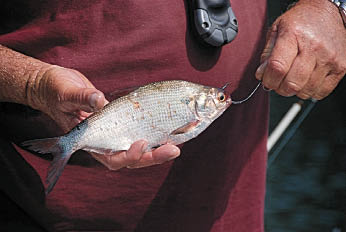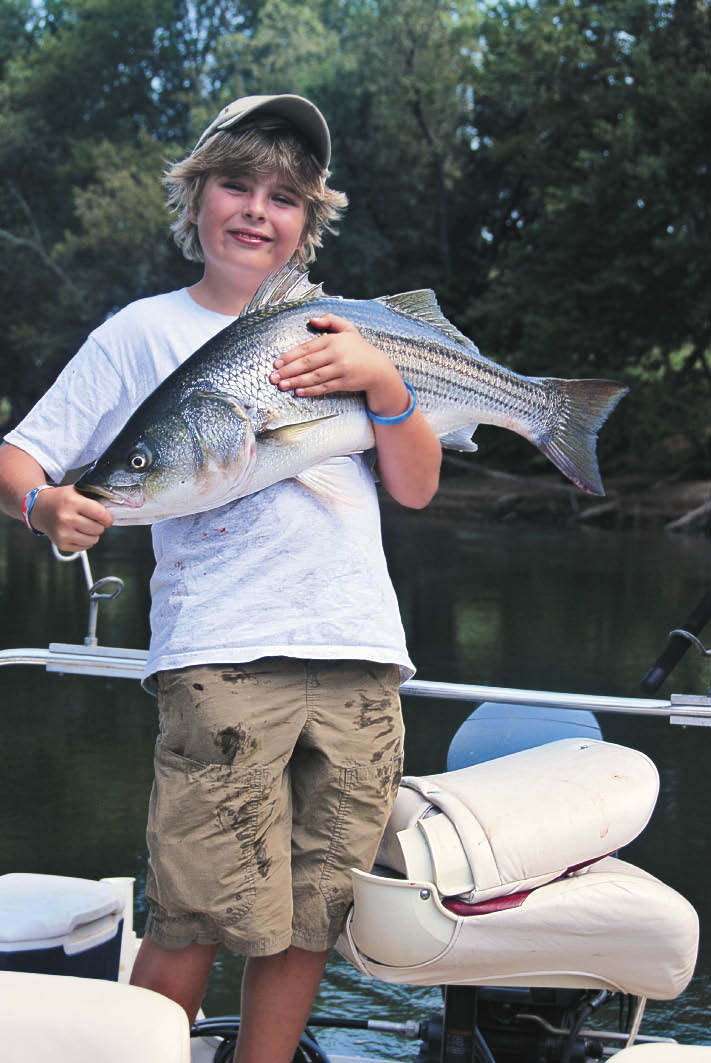 We were trolling identical crankbaits from rod holders that sprouted from the bow corners of our pontoon, hoping to ice a dozen or so late-season white bass. My son and I had switched to the same shallow-diving Rapala after mine got two hits to none over his Hot 'n' Tot, figuring we had dialed-in to the baits the finicky bass preferred that October afternoon-and hoping to double up on the action.
We were trolling identical crankbaits from rod holders that sprouted from the bow corners of our pontoon, hoping to ice a dozen or so late-season white bass. My son and I had switched to the same shallow-diving Rapala after mine got two hits to none over his Hot 'n' Tot, figuring we had dialed-in to the baits the finicky bass preferred that October afternoon-and hoping to double up on the action.
As we zig-zagged over the impoundment's original creek bed, 12 feet below, my lure continued to get slammed by the silver-sided fighters, and I could see young Ethan get more and more frustrated as his identical bait went untouched.
Feeling his angst, I asked him to reel in his bait and show me that it was running "true" at the 2.5 mph speed we were cruising. That's fast compared to the sub-2 mph trolling speed we typically employ when targeting walleyes and crappies earlier in the season, and I wanted to make sure the lure was running straight and not turning to one side with the pressure of the fleeter speeds, and running more shallow and less natural than intended. It was one of the first lessons I taught my son when he was able to deploy baits himself, to let out a little line and watch the lure boatside as it ran, or give the bait a couple of practice casts and watch the lure as it approached to make sure it looked right. So I guess I deserved the `stink eye' I received in reply to my request.
"I checked the lure Dad; it was running great," he said, exasperated and impatient with me for even suggesting that he had over looked the important pre-fishing ritual.
Knowing the lure was running "true," we traded sides of the boat, placing his rod in the "hot" starboard holder where mine had received all the attention, and securing my rod in the port-side Tite-Lok holder. When trolling a shoreline with a steep break, sometimes the difference in depth from one side of the boat to the other can be several feet and spell the difference between one lure getting into the fish zone and the other-a dozen feet away-being ignored. However, because we were trolling back and forth over the creek bed and directing the baits over the deeper water and then across the adjacent flats to find and prompt strikes from the roaming schools of white bass, I wasn't optimistic that the rod location "tweak" would pay off. I was beginning to wonder myself why my presentation was working and my son's was not when his lure snagged a submerged stump, the rod bent double, and his line snapped before we could throttle down.
"THAT was quick," I commented, noting how easily the line parted. By switching to heavier line when trolling, usually we have time to slow the boat and get into reverse as the reel's drag releases line in time to retrieve a bait that's hung up. "What pound test line do you have on that reel anyway?"
 "Uh, four," he answered rather sheepishly, then quickly tried to salvage his situation: "I didn't want to have to switch over from when we were crappie fishing and thought the lighter line might help me get more bites since the water's so clear."
"Uh, four," he answered rather sheepishly, then quickly tried to salvage his situation: "I didn't want to have to switch over from when we were crappie fishing and thought the lighter line might help me get more bites since the water's so clear."
Compared to the 12-pound-test I was using to troll over the stump-filled shallows, the smaller-diameter four-pound-test line Ethan had stuck with allowed his identical lure to run deeper that mine-putting it too far below the view of cruising bass but at just the right depth to collide with the occasional stump.
The line size was a detail I had referenced -but not emphasized-while tutoring my fishing partner on the tweaking that can make a difference between fishing and catching fish.
I was proud that he had tested his lure to make sure it ran correctly, and appreciated his `argument' for using the lighter line in the clear, late-season waters, so I bit my tongue as I broke out a 12-pound-test spinning outfit for him. I did make him watch as I carefully tied on a replacement Rapala, using an open-cinched Uni-knot to leave a loop.
As I recall, with the proper rig it didn't take long for Ethan to even the odds catch-wise and he returned home a happy angler, with a fresh appreciation for the all-important "small stuff."
Such as that Uni-knot loop knot. A crankbait that's supposed to wiggle will do so with my more appeal when its attachment eye is threaded with a loose loop rather than clenched firmly with a tight-cinched knot. On the other hand, that tight-cinched Uni-knot or a traditional clinch knot snubbed down around the eye is exactly what's called for if it's a right-angled hook, with the eye coming out of the top of a jig head. By tightening down the knot with the line perpendicular to the jig's body, the bait will hang horizontally in the water, presenting a silhouette that better mimics the baitfish it's supposed to simulate.
Proper knots and line size are a few of the tweaks that often mean the difference between a good day and a great day of fishing. Sometimes, such details can make all the difference in the world-as that world revolves around angling, anyway.
Switching out colors and sizes of lures seems easy enough to do-until you are out on the water and find yourself pitching the same old bait time and again while figuring the fish "simply aren't biting." The bait that worked yesterday-or even this morning-can quickly get the cold shoulder as fish switch gears and can be tempted by other presentations. The same goes for retrieve or trolling speeds. We typically troll an hour-or-more-per-hour faster this time of the year than we did a month ago, simply because the metabolism of most gamefish has turned up a notch with the cooler water and the feeding that they are prompted to partake in as the winter months approach.
Lure size often goes up a notch or two now too, as the baitfish in local waters grow with the advancing season. Tiny shad-imitating lures that were so tempting-and successful-in May may not turn the head of a fish that's been gorging on more mature population of shad made up of individuals that may have grown to triple their size since spring. Come autumn (or any time of the year, for that matter), try to match the hatch of the current baitfish in terms of size and species, and don't be afraid to break out the biggest baits in your box. You may be rewarded with the season's biggest catch.
Uni-knot and Clinch knot illustrations:
http://www.fish4fun.com/clinch_knot.htm
http://www.fish4fun.com/Lines_to_Tackle.htm

